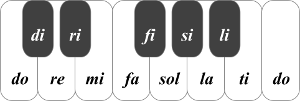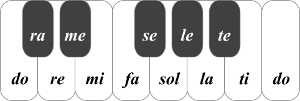An Introduction to Chromatic-Solfege
Chromatic-Solfege is a variant of Solfege. While Solfege is based on a diatonic scale, Chromatic-Solfege is based on the twelve-note chromatic scale. This is a very powerful tool for improving your skill of improvisation especially in Jazz. Following pictures are a summary of the note names of Chromatic-Solfege.
| Ascending Chromatic Scale | Descending Chromatic Scale |
|---|---|
 |
 |
The Comprehensive Exercise Patterns of Chromatic-Solfege
Since the name system of Solfege is based on the diatonic scale, half tones are usually named with a modifier such as a sharp a flat as C♯ or D♭. In Chromatic-Solfege, every tone in the Chromatic-Solfege are distinctively named as do di re ri me mi fa …; the modifiers are not necessary anymore.
In order to get accustomed to these note names, you may need some comprehensive exercises; therefore, I have made a series of exercises. I have written an article about the exercises with music scores, audio data and videos. The article is called An Introduction to Chromatic-Solfege(pdf).
The Extended Chromatic-Solfege and its Exercise Patterns
I have extended the note naming rule of Chromatic-Solfege into a new form which I believe is more suitable to improve your ability of improvising. The extension covers modifying the naming rule for double, triple and quadruple accidentals. Those irregular accidentals are useful to analyzing pieces of polymodal music. The article also explains about the extension.
This Extended Chromatic-Solfege have backward-compatibility with the general Chromatic-Solfege; hence, it is not a modified Chromatic-Solfege but extended Chromatic-Solfege.
Download the “An Introduction to Chromatic-Solfege”(pdf)
Source Code
The An Introduction to Chromatic-Solfege is written in Chromadoc. The source code is available on git repository.